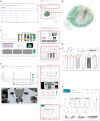This is a preprint.
Interactive data exploration websites for large-scale electrophysiology
- PMID: 38915704
- PMCID: PMC11195081
- DOI: 10.1101/2024.06.07.597950
Interactive data exploration websites for large-scale electrophysiology
Abstract
Methodological advances in neuroscience have enabled the collection of massive datasets which demand innovative approaches for scientific communication. Existing platforms for data storage lack intuitive tools for data exploration, limiting our ability to interact effectively with these brain-wide datasets. We introduce two public websites: (Data and Atlas) developed for the International Brain Laboratory which provide access to millions of behavioral trials and hundreds of thousands of individual neurons. These interfaces allow users to discover both the raw and processed brain-wide data released by the IBL at the scale of the whole brain, individual sessions, trials, and neurons. By hosting these data interfaces as websites they are available cross-platform with no installation. By releasing each site's code as a modular open-source framework, other researchers can easily develop their own web interfaces and explore their own data. As neuroscience datasets continue to expand, customizable web interfaces offer a glimpse into a future of streamlined data exploration and act as blueprints for future tools.
Figures



References
-
- Foster E. D., & Deardorff A. (2017). Open science framework (osf). Journal of the Medical Library Association: JMLA, 105 (2), 203.
Publication types
Grants and funding
LinkOut - more resources
Full Text Sources
Research Materials
